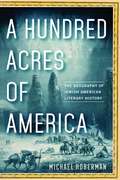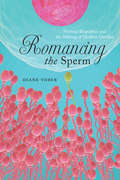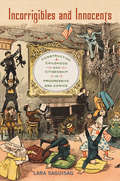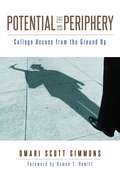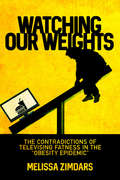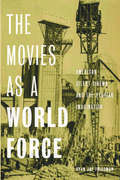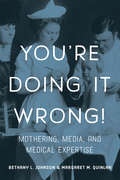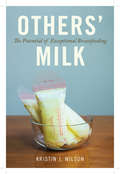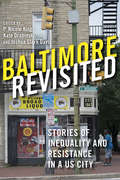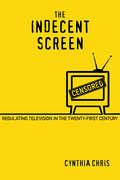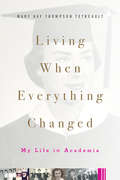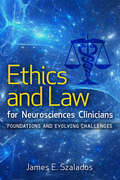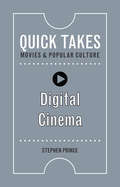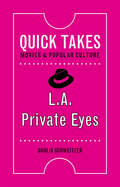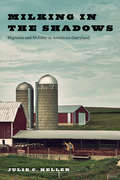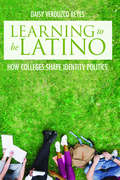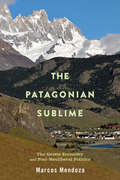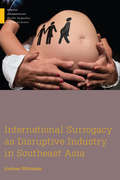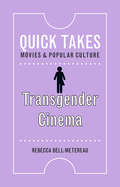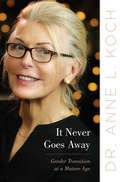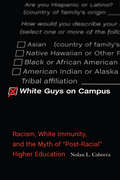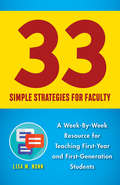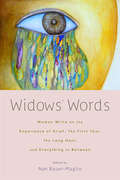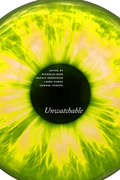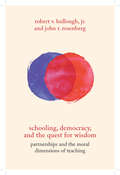- Table View
- List View
A Hundred Acres of America: The Geography of Jewish American Literary History
by Michael HobermanJewish writers have long had a sense of place in the United States, and interpretations of American geography have appeared in Jewish American literature from the colonial era forward. But troublingly, scholarship on Jewish American literary history often limits itself to an immigrant model, situating the Jewish American literary canon firmly and inescapably among the immigrant authors and early environments of the early twentieth century. In A Hundred Acres of America, Michael Hoberman combines literary history and geography to restore Jewish American writers to their roles as critical members of the American literary landscape from the 1850s to the present, and to argue that Jewish history, American literary history, and the inhabitation of American geography are, and always have been, contiguous entities.
Romancing the Sperm: Shifting Biopolitics and the Making of Modern Families
by Diane ToberThe 1990s marked a new era in family formation. Increased access to donor sperm enabled single women and lesbian couples to create their families on their own terms, outside the bounds of heterosexual married relationships. However, emerging “alternative” families were not without social and political controversy. Women who chose to have children without male partners faced many challenges in their quest to have children. Despite current wider social acceptance of single people and same sex couples becoming parents, many of these challenges continue. In Romancing the Sperm, Diane Tober explores the intersections between sperm donation and the broader social and political environment in which “modern families” are created and regulated. Through tangible and intimate stories, this book provides a captivating read for anyone interested in family and kinship, genetics and eugenics, and how ever-expanding assisted reproductive technologies continue to redefine what it means to be human.
Incorrigibles and Innocents: Constructing Childhood and Citizenship in Progressive Era Comics
by Lara SaguisagHistories and criticism of comics note that comic strips published in the Progressive Era were dynamic spaces in which anxieties about race, ethnicity, class, and gender were expressed, perpetuated, and alleviated. The proliferation of comic strip children—white and nonwhite, middle-class and lower class, male and female—suggests that childhood was a subject that fascinated and preoccupied Americans at the turn of the century. Many of these strips, including R.F. Outcault’s Hogan’s Alley and Buster Brown, Rudolph Dirks’s The Katzenjammer Kids and Winsor McCay’s Little Nemo in Slumberland were headlined by child characters. Yet no major study has explored the significance of these verbal-visual representations of childhood. Incorrigibles and Innocents addresses this gap in scholarship, examining the ways childhood was depicted and theorized in late nineteenth- and early twentieth-century comic strips. Drawing from and building on histories and theories of childhood, comics, and Progressive Era conceptualizations of citizenship and nationhood, Lara Saguisag demonstrates that child characters in comic strips expressed and complicated contemporary notions of who had a right to claim membership in a modernizing, expanding nation.
Potential on the Periphery: College Access from the Ground Up
by Omari Scott SimmonsEven high-performing students sometimes need assistance to transform their high school achievement into a higher education outcome that matches their potential, especially when those students come from vulnerable backgrounds. Without intervention, many of these students, lost in the transition between secondary school and higher education, would not attend selective colleges that provide greater opportunities. Potential on the Periphery profiles the Simmons Memorial Foundation (SMF), a grassroots non-profit organization co-founded by author Omari Scott Simmons, that promotes college access for students in North Carolina and Delaware. Simmons discusses how the organization has helped students secure admission and succeed in college, using this example to contextualize the broader realm of existing education practice, academic theory, and public policy. Using data gleaned from interviews with past student participants in the programs run by the SMF, Simmons illuminates the underlying factors thwarting student achievement, such as inadequate information about college options, limited opportunities for social capital acquisition, financial pressures, self-doubt, and political weakness. Simmons then identifies policy solutions and pragmatic strategies that college access organizations can adopt to address these factors.
Watching Our Weights: The Contradictions of Televising Fatness in the “Obesity Epidemic”
by Melissa ZimdarsWatching Our Weights explores the competing and contradictory fat representations on television that are related to weight-loss and health, medicalization and disease, and body positivity and fat acceptance. While television—especially reality television—is typically understood to promote individual self-discipline and expert interventions as necessary for transforming fat bodies into thin bodies, fat representations and narratives on television also create space for alternative as well as resistant discourses of the body. Melissa Zimdars thus examines the resistance inherent within TV representations and narratives of fatness as a global health issue, the inherent and overt resistance found across stories of medicalized fatness, and programs that actively avoid dieting narratives in favor of less oppressive ways of thinking about the fat body. Watching Our Weights weaves together analyses of media industry lore and decisions, communication and health policies, medical research, activist projects, popular culture, and media texts to establish both how television shapes our knowledge of fatness and how fatness helps us better understand contemporary television.
The Movies as a World Force: American Silent Cinema and the Utopian Imagination
by Ryan Jay FriedmanThroughout the silent-feature era, American artists and intellectuals routinely described cinema as a force of global communion, a universal language promoting mutual understanding and harmonious coexistence amongst disparate groups of people. In the early 1920s, film-industry leaders began to espouse this utopian view, in order to claim for motion pictures an essentially uplifting social function. The Movies as a World Force examines the body of writing in which this understanding of cinema emerged and explores how it shaped particular silent films and their marketing campaigns. The utopian and universalist view of cinema, the book shows, represents a synthesis of New Age spirituality and the new liberalism. It provided a framework for the first official, written histories of American cinema and persisted as an advertising trope, even after the transition to sound made movies reliant on specific national languages.
You're Doing it Wrong!: Mothering, Media, and Medical Expertise
by Bethany L. Johnson Margaret M. QuinlanNew mothers face a barrage of confounding decisions during the life-cycle of early motherhood which includes... Should they change their diet or mindset to conceive? Exercise while pregnant? Should they opt for a home birth or head for a hospital? Whatever they “choose,” they will be sure to find plenty of medical expertise from health practitioners to social media “influencers” telling them that they’re making a series of mistakes. As intersectional feminists with two small children each, Bethany L. Johnson and Margaret M. Quinlan draw from their own experiences as well as stories from a range of caretakers throughout. You’re Doing it Wrong! investigates the storied history of mothering advice in the media, from the newspapers, magazines, doctors’ records and personal papers of the nineteenth-century to today’s websites, Facebook groups, and Instagram feeds. Johnson and Quinlan find surprising parallels between today’s mothering experts and their Victorian counterparts, but they also explore how social media has placed unprecedented pressures on new mothers, even while it may function as social support for some. They further examine the contentious construction of prenatal and baby care expertise itself, as individuals such as everyone from medical professionals to experienced moms have competed to have their expertise acknowledged in the public sphere. Exploring potential health crises from infertility treatments to “better babies” milestones, You’re Doing it Wrong! provides a provocative look at historical and contemporary medical expertise during conception, pregnancy, childbirth, postpartum, and infant care stages.
Others' Milk: The Potential of Exceptional Breastfeeding
by Kristin J. WilsonBreastfeeding rarely conforms to the idealized Madonna-and-baby image seen in old artwork, now re-cast in celebrity breastfeeding photo spreads and pro-breastfeeding ad campaigns. The personal accounts in Others’ Milk illustrate just how messy and challenging and unpredictable it can be—an uncomfortable reality in the contemporary context of high-stakes motherhood in which “successful” breastfeeding proves one’s maternal mettle. Exceptional breastfeeders find creative ways to feed and care for their children—such as by inducing lactation, sharing milk, or exclusively pumping. They want to adhere to the societal ideal of giving them “the best” but sometimes have to face off with dogmatic authorities in order to do so. Kristin J. Wilson argues that while breastfeeding is never going to be the feasible choice for everyone, it should be accessible to anyone.
Baltimore Revisited: Stories of Inequality and Resistance in a U.S. City
by Lawrence Brown Daniel L. Buccino Michael Casiano Sam Collins Shannon Darrow Matthew Durington Nicole Fabricant Aiden Faust Jennifer A. Ferretti Leif Fredrickson Robert Gamble Marisela Gomez April K. Householder Jodi Kelber-Kaye Louise Parker Kelley Emily Lieb Jacob R. Levin Teresa Méndez Ashley Minner Elizabeth M. Nix Richard E. Otten Eli Pousson Mary Rizzo Fred Scharmen Aletheia Hyun-Jin Shin Linda Shopes Michelle L. Stefano Joe Tropea Amy Zanoni Denise Meringolo Robert Headley Shawntay StocksNicknamed both “Mobtown” and “Charm City” and located on the border of the North and South, Baltimore is a city of contradictions. From media depictions in The Wire to the real-life trial of police officers for the murder of Freddie Gray, Baltimore has become a quintessential example of a struggling American city. Yet the truth about Baltimore is far more complicated—and more fascinating. To help untangle these apparent paradoxes, the editors of Baltimore Revisited have assembled a collection of over thirty experts from inside and outside academia. Together, they reveal that Baltimore has been ground zero for a slew of neoliberal policies, a place where inequality has increased as corporate interests have eagerly privatized public goods and services to maximize profits. But they also uncover how community members resist and reveal a long tradition of Baltimoreans who have fought for social justice. The essays in this collection take readers on a tour through the city’s diverse neighborhoods, from the Lumbee Indian community in East Baltimore to the crusade for environmental justice in South Baltimore. Baltimore Revisited examines the city’s past, reflects upon the city’s present, and envisions the city’s future.
The Indecent Screen: Regulating Television in the Twenty-First Century
by Cynthia ChrisThe Indecent Screen explores clashes over indecency in broadcast television among U.S.-based media advocates, television professionals, the Federal Communications Commission, and TV audiences. Cynthia Chris focuses on the decency debates during an approximately twenty-year period since the Telecommunications Act of 1996, which in many ways restructured the media environment. Simultaneously, ever increasing channel capacity, new forms of distribution, and time-shifting (in the form of streaming and on-demand viewing options) radically changed how, when, and what we watch. But instead of these innovations quelling concerns that TV networks were too often transmitting indecent material that was accessible to children, complaints about indecency skyrocketed soon after the turn of the century. Chris demonstrates that these clashes are significant battles over the role of family, the role of government, and the value of free speech in our lives, arguing that an uncensored media is so imperative to the public good that we can, and must, endure the occasional indecent screen.
Living When Everything Changed: My Life in Academia
by Mary Kay TetreaultEntering the academy at the dawn of the women’s rights movement in the late 1960s and early 1970s, the first generation of feminist academics had a difficult journey. With few female role models, they had to forge their own path and prove that feminist scholarship was a legitimate enterprise. Later, when many of these scholars moved into administrative positions, hoping to reform the university system from within, they encountered entrenched hierarchies, bureaucracies, and old boys’ networks that made it difficult to put their feminist principles into practice. In this compelling memoir, Mary Kay Thompson Tetreault describes how a Catholic girl from small-town Nebraska discovered her callings as a feminist, as an academic, and as a university administrator. She recounts her experiences at three very different schools: the small progressive Lewis & Clark College, the massive regional university of Cal State Fullerton, and the rapidly expanding Portland State University. Reflecting on both her accomplishments and challenges, she considers just how much second-wave feminism has transformed academia and how much reform is still needed. With remarkable candor and compassion, Thompson Tetreault provides an intimate personal look at an era when both women’s lives and university culture changed for good. The Acknowledgments were inadvertently left out of the first printing of this book. We apologize for the oversight, and offer them here instead. Future printings will include this information. (https://d3tto5i5w9ogdd.cloudfront.net/wp-content/uploads/2019/08/29185420/Thompson-Tetreault-Acknowledgments.pdf)
Ethics and Law for Neurosciences Clinicians: Foundations and Evolving Challenges (Clinical Neurology Best Practices)
by James E SzaladosThe brain represents the final frontier in medical sciences. Clinical neurosciences include the subspecialties of neurology, neurosurgery, neuro-imaging, cerebrovascular interventional specialties, neurocritical care, and the allied specialties in pharmacy and nursing. The first lens through which we see our patients is the clinical perspective; however, the complexity of neurosciences and the rapidity of the advances in these subspecialties require that clinicians not lose sight of the personhood of the patients, the professionalism required in the care of these complex patients, or the regulatory environment in which we practice. Science and technology are advancing more rapidly than regulations or the law can interpret and integrate them into a supportive or regulatory framework. Thus, morality, ethics, and the law comprise the final lens through which we approach complex patient management issues, frame our communications with patients and families, and evaluate the risks and potential benefits of new technology. Ethics and Law for Neurosciences Clinicians is written for all clinicians in the neurosciences specialties to examine and re-examine the ethical and legal implications of advances in clinical neurosciences.
Digital Cinema: The Seduction Of Reality (Quick Takes: Movies and Popular Culture)
by Stephen PrinceDigital Cinema considers how new technologies have revolutionized the medium, while investigating the continuities that might remain from filmmaking’s analog era. In the process, it raises provocative questions about the status of realism in a pixel-generated digital medium whose scenes often defy the laws of physics. It also considers what these changes might bode for the future of cinema. How will digital works be preserved and shared? And will the emergence of virtual reality finally consign cinema to obsolescence? Stephen Prince offers a clear, concise account of how digital cinema both extends longstanding traditions of filmmaking and challenges some fundamental assumptions about film. It is essential reading for anyone interested in understanding how movies are shot, produced, distributed, and consumed in the twenty-first century.
L.A. Private Eyes (Quick Takes: Movies and Popular Culture)
by Dahlia SchweitzerL.A. Private Eyes examines the tradition of the private eye as it evolves in films, books, and television shows set in Los Angeles from the 1930’s through the present day. It takes a closer look at narratives—both on screen and on the printed page—in which detectives travel the streets of Los Angeles, uncovering corruption, moral ambiguity, and greed with the conviction of urban cowboys, while always ultimately finding truth and redemption. With a review of Los Angeles history, crime stories, and film noir, L.A. Private Eyes explores the metamorphosis of the solitary detective figure and the many facets of the genre itself, from noir to mystery, on the screen. While the conventions of the genre may have remained consistent and recognizable, the points where they evolve illuminate much about our changing gender and power roles. Watch a video of the author speaking about this topic: https://goo.gl/Xr9RFD And also: https://www.dropbox.com/s/mkqw3mplruf7jje/Detective%20Talk%20Full.mp4?dl=0 (https://www.dropbox.com/s/mkqw3mplruf7jje/Detective%20Talk%20Full.mp4?dl=0)
Milking in the Shadows: Migrants and Mobility in America’s Dairyland (Inequality at Work: Perspectives on Race, Gender, Class, and Labor)
by Julie C. KellerMigrant workers live in a transnational world that spans the boundaries of nation-states. Yet for undocumented workers, this world is complicated by inflexible immigration policies and the ever-present threat of enforcement. Workers labeled as “illegals” wrestle with restrictive immigration policies, evading border patrol and local police as they risk their lives to achieve economic stability for their families. For this group of workers, whose lives in the U.S. are largely defined by their tenuous legal status, the sacrifices they make to get ahead entail long periods of waiting, extended separation from family, and above all, tremendous uncertainty around a freedom that many of us take for granted—everyday mobility. In Milking in the Shadows, Julie Keller takes an in-depth look at a population of undocumented migrants working in the American dairy industry to understand the components of this labor system. This book offers a framework for understanding the disjuncture between the labor desired by employers and life as an undocumented worker in America today.
Learning to Be Latino: How Colleges Shape Identity Politics (Critical Issues in American Education)
by Daisy Verduzco ReyesIn Learning to Be Latino, sociologist Daisy Verduzco Reyes paints a vivid picture of Latino student life at a liberal arts college, a research university, and a regional public university, outlining students’ interactions with one another, with non-Latino peers, and with faculty, administrators, and the outside community. Reyes identifies the normative institutional arrangements that shape the social relationships relevant to Latino students’ lives, including school size, the demographic profile of the student body, residential arrangements, the relationship between students and administrators, and how well diversity programs integrate students through cultural centers and retention centers. Together these characteristics create an environment for Latino students that influences how they interact, identify, and come to understand their place on campus. Drawing on extensive ethnographic observations, Reyes shows how college campuses shape much more than students’ academic and occupational trajectories; they mold students’ ideas about inequality and opportunity in America, their identities, and even how they intend to practice politics.
The Patagonian Sublime: The Green Economy and Post-Neoliberal Politics
by Marcos MendozaThe Patagonian Sublime provides a vivid, accessible, and cutting-edge investigation of the green economy and New Left politics in Argentina. Based on extensive field research in Glaciers National Park and the mountain village of El Chaltén, Marcos Mendoza deftly examines the diverse social worlds of alpine mountaineers, adventure trekkers, tourism entrepreneurs, seasonal laborers, park rangers, land managers, scientists, and others involved in the green economy. Mendoza explores the fraught intersection of the green economy with the New Left politics of the Néstor Kirchner and Cristina Fernández de Kirchner governments. Mendoza documents the strategies of capitalist development, national representation, and political rule embedded in the “green productivist” agenda pursued by Kirchner and Fernández. Mendoza shows how Andean Patagonian communities have responded to the challenges of community-based conservation, the fashioning of wilderness zones, and the drive to create place-based monopolies that allow ecotourism destinations to compete in the global consumer economy.
International Surrogacy as Disruptive Industry in Southeast Asia (Medical Anthropology)
by Andrea WhittakerDuring the last two decades, a new form of trade in commercial surrogacy grew across Asia. Starting in India, a “disruptive” model of surrogacy offered mass availability, rapid accessibility, and created new demands for surrogacy services from people who could not afford or access surrogacy elsewhere. In International Surrogacy as Disruptive Industry in Southeast Asia, Andrea Whittaker traces the development of this industry and its movement across Southeast Asia following a sequence of governmental bans in India, Nepal, Thailand, and Cambodia. Through a case study of the industry in Thailand, the book offers a nuanced and sympathetic examination of the industry from the perspectives of the people involved in it: surrogates, intended parents, and facilitators. The industry offers intended parents the opportunity to form much desired families, but also creates vulnerabilities for all people involved. These vulnerabilities became evident in cases of trafficking, exploitation, and criminality that emerged in southeast Asia, leading to greater scrutiny on the industry as a whole. Yet the trade continues in new flexible hybrid forms, involving the circulation of reproductive gametes, embryos, surrogates, and ova donors across international borders to circumvent regulations. The book demonstrates the need for new forms of regulation to protect those involved in international surrogacy arrangements.
Transgender Cinema (Quick Takes: Movies and Popular Culture)
by Rebecca Bell-MetereauTransgender Cinema gives readers the big picture of how trans people have been depicted on screen. Beginning with a history of trans tropes in classic Hollywood cinema, from comic drag scenes in Chaplin’s The Masquerader to Garbo’s androgynous Queen Christina, and from psycho killer queers to The Rocky Horror Picture Show’s outrageous queen, it examines a plethora of trans portrayals that subsequently emerged from varied media outlets, including documentary films, television serials, and world cinema. Along the way, it analyzes milestones in trans representation, like The Crying Game, Boys Don’t Cry, Hedwig and the Angry Inch,and A Fantastic Woman. As it traces the evolution of trans people onscreen, Transgender Cinema also considers the ongoing controversies sparked by these movies and series both within LGBTQ communities and beyond. Ultimately it reveals how film and television have shaped not only how the general public sees trans people, but also how trans people see themselves.
It Never Goes Away: Gender Transition at a Mature Age
by Anne Lauren KochIf you are transgendered, the feeling of wanting your body to match the sex you feel you are never goes away. For some, though, especially those who grew up before trans people were widely out and advocating for equality, these feelings were often compartmentalized and rarely acted upon. Now that gender reassignment has become much more commonplace, many of these people may feel increasing pressure to finally undergo the procedures they have always secretly wanted. Ken Koch was one of those people. Married twice, a veteran, and a world traveler, a health scare when he was sixty-three prompted him to acknowledge the feelings that had plagued him since he was a small child. By undergoing a host of procedures, he radically changed his appearance and became Anne Koch. In the process though, Anne lost everything that Ken had accomplished. She had to remake herself from the ground up. Hoping to help other people in her age bracket who may be considering transitioning, Anne describes the step by step procedures that she underwent, and shares the cost to her personal life, in order to show seniors that although it is never too late to become the person you always knew you were, it is better to go into that new life prepared for some serious challenges. Both a fascinating memoir of a well-educated man growing up trans yet repressed in the mid-twentieth century, and a guidebook to navigating the tricky waters of gender reassignment as a senior, It Never Goes Away shows how what we see in the television world of Transparent translates in real life.
White Guys on Campus: Racism, White Immunity, and the Myth of "Post-Racial" Higher Education (The American Campus)
by Nolan L CabreraOn April 22, 2015, Boston University professor Saida Grundy set off a Twitter storm with her provocative question: “Why is white America so reluctant to identify white college males as a problem population?” White Guys on Campus is a critical examination of race in higher education, centering Whiteness, in an effort to unveil the frequently unconscious habits of racism among White male undergraduates. Nolan L. Cabrera moves beyond the “few bad apples” frame of contemporary racism, and explores the structures, policies, ideologies, and experiences that allow racism to flourish. This book details many of the contours of contemporary, systemic racism, while engaging the possibility of White students to participate in anti-racism. Ultimately, White Guys on Campus calls upon institutions of higher education to be sites of social transformation instead of reinforcing systemic racism, while creating a platform to engage and challenge the public discourse of “post- racialism.”
33 Simple Strategies for Faculty: A Week-By-Week Resource for Teaching First-Year and First-Generation Students
by Lisa M. NunnMany students struggle with the transition from high school to university life. This is especially true of first-generation college students, who are often unfamiliar with the norms and expectations of academia. College professors usually want to help, but many feel overwhelmed by the prospect of making extra time in their already hectic schedules to meet with these struggling students. 33 Simple Strategies for Faculty is a guidebook filled with practical solutions to this problem. It gives college faculty concrete exercises and tools they can use both inside and outside of the classroom to effectively bolster the academic success and wellbeing of their students. To devise these strategies, educational sociologist Lisa M. Nunn talked with a variety of first-year college students, learning what they find baffling and frustrating about their classes, as well as what they love about their professors’ teaching. Combining student perspectives with the latest research on bridging the academic achievement gap, she shows how professors can make a difference by spending as little as fifteen minutes a week helping their students acculturate to college life. Whether you are a new faculty member or a tenured professor, you are sure to find 33 Simple Strategies for Faculty to be an invaluable resource.
Widows' Words: Women Write on the Experience of Grief, the First Year, the Long Haul, and Everything in Between
by Alice Goode-Elman Kelli Dunham Penelope Dugan Melanie K Finney Ellen Schrecker Raquel Ramkhelawan Maxine Marshall Lauren Vanett Alice Derry Michele Neff Hernandez Elisa Clark Wadham Deborah E Kaplan P. C. Moorehead Mimi Schwartz Anne Bernays Edie Butler Debby Mayer Sonia Jaffe Robbins Barbara Marwell Maggie Madagame Roni Sherman Ramos Doris Friedensohn Nancy H Womack Joan Michelson Tracy Milcendeau Merle Froschl Andrea Hirshman Molly A McEneny Heather Slawecki Kathleen Fordyce Patricia Life Nancy Shamban Susanne Braham Alice Radosh Parvin Hajizadeh Jean Y Leung Joan Gussow Kathryn Temple Carrie L West Lise Menn Christine Silverstein Tara SabharwalBecoming a widow is one of the most traumatic life events that a woman can experience. Yet, as this remarkable new collection reveals, each woman responds to that trauma differently. Here, forty-three widows tell their stories, in their own words. Some were widowed young, while others were married for decades. Some cared for their late partners through long terminal illnesses, while others lost their partners suddenly. Some had male partners, while others had female partners. Yet each of these women faced the same basic dilemma: how to go on living when a part of you is gone. Widows’ Words is arranged chronologically, starting with stories of women preparing for their partners’ deaths, followed by the experiences of recent widows still reeling from their fresh loss, and culminating in the accounts of women who lost their partners many years ago but still experience waves of grief. Their accounts deal honestly with feelings of pain, sorrow, and despair, and yet there are also powerful expressions of strength, hope, and even joy. Whether you are a widow yourself or have simply experienced loss, you will be sure to find something moving and profound in these diverse tales of mourning, remembrance, and resilience.
Unwatchable
by Erika Balsom Kenneth Berger Susie Bright Alex Bush Alec Butler Noel Carroll Mel Chen Jonathan Crary Abigail De Kosnik Samuel England Mattias Frey Peter Geimer Michael Boyce Gillespie Asbjørn Grønstad Boris Groys Frances Guerin Jack Halberstam Barbara Hammer Julian Hanich Stefano Harney J. Hoberman Lynne Joyrich Alexandra Juhasz E. Ann Kaplan Katariina Kyrölä Nathan Lee Akira Lippit Jennifer Malkowski W.J.T. Mitchell Brandy Monk-Payton Fred Moten Bill Nichols Jan Olsson Danielle Peers Raul Perez Mauro Resmini B. Ruby Rich Elif Rongen-Kaynakçi Jonathan Rosenbaum Rebecca Schneider Jeffrey Sconce Jared Sexton Philipp Stiasny Meghan Sutherland Bennet Togler Leshu Torchin Alok Vaid-Menon Christophe Wall-Romana Meir Wigoder Emily Wills Federico Windhausen Stanley Wolukau-Wanambwa Genevieve Yue Alenka Zupancic Poulomi Saha Vivian SobchackWe all have images that we find unwatchable, whether for ethical, political, or sensory and affective reasons. From news coverage of terror attacks to viral videos of police brutality, and from graphic horror films to transgressive artworks, many of the images in our media culture might strike us as unsuitable for viewing. Yet what does it mean to proclaim something “unwatchable”: disturbing, revolting, poor, tedious, or literally inaccessible? With over 50 original essays by leading scholars, artists, critics, and curators, this is the first book to trace the “unwatchable” across our contemporary media environment, in which viewers encounter difficult content on various screens and platforms. Appealing to a broad academic and general readership, the volume offers multidisciplinary approaches to the vast array of troubling images that circulate in global visual culture.
Schooling, Democracy, and the Quest for Wisdom: Partnerships and the Moral Dimensions of Teaching
by Robert V Bullough John R RosenbergIn response to growing concern in the 1980s about the quality of public education across the United States, a tremendous amount of energy was expended by organizations such as the Holmes Group and the Carnegie Forum to organize professional development schools (PDS) or “partner schools” for teacher education. On the surface, the concept of partnering is simple; however, the practice is very costly, complex, and difficult. In Schooling, Democracy, and the Quest for Wisdom, Robert V. Bullough, Jr. and John R. Rosenberg examine the concept of partnering through various lenses and they address what they think are the major issues that need to be, but rarely are, discussed by thousands of educators in the U.S. who are involved and invested in university-public school partnerships. Ultimately, they assert that the conversation around partnering needs re-centering (most especially on the purposes of public education), refreshing, and re-theorizing.
